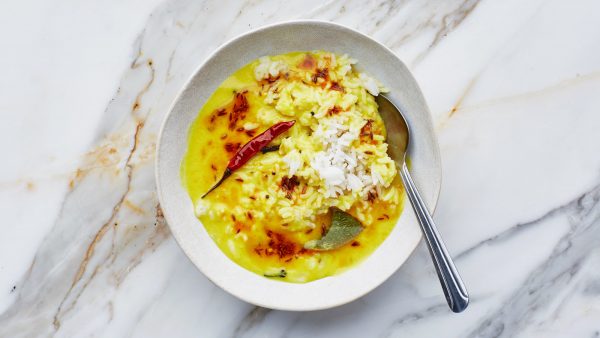So this is National Curry Week- a strange concept to me in many ways, not least of all because there is actually no such thing as curry in India. Every dish has its own name, and no meal is seen generically as ‘curry’, which is simply an English term for Indian food. There are various explanations as to how the word came to be used by the British, and indeed by many others around the world. It is most definitely a borrowed word, possibly from kadhi or karhi, which is a soup like dish made with a gram flour (chickpea) based thick gravy, and spices. In some regions of India, pakoras (vegetable fritters) are added to the kadhi, a bit like dumplings might be added to broths in South East Asian cuisines.
My mother grew up in the north western Indian state of Gujarat. There, the food is traditionally vegetarian, and tends to be slightly sweet and spicy. It is also as Ayurvedically balanced as one can get, with most everyday meals comprising all 6 Ayurvedic tastes of sweet, sour, salty, pungent, bitter and astringent. This means that one is left feeling satiated, and cravings are kept at bay.
My love of Gujarati food is as deep as a bottomless well; this food is unwaveringly moreish, and it nourishes my soul with every mouthful. When I eat my mother’s food, I am at once transported back to my early childhood, to a time when my world was safely contained in a small house on a quiet, Yorkshire street. It evokes the sounds of my family’s chit-chat, my dear late father’s (he would have been 89 today) dulcet tones calling his three children to the supper table, whilst my mother brought to our plates, gifts of dainty, just made,hot,uniquely Gujarati chapatis, dripping with toffee- scented ghee. These were her speciality; perfectly round daily offerings of motherlove.

Gujarati Kadhi
Our meals always consisted of chapatis, a dal or kadhi, a vegetable dish or two, some pickle or chutney, and rice. Rice is eaten last in Gujarati homes, and covered with any of the vegetables and dal or kadhi that are left, often with some homemade yogurt, and everything is mixed thoroughly before being eaten.
So I want to offer you, during this week of appreciating Indian cuisine, my mother’s delicious Gujarati kadhi, because it is the only ‘curry’ we have ever eaten in our household.
Serve poured over a bowl of basmati rice with perhaps some yogurt and spicy pickle.
To serve 4:
- 400ml plain yogurt
- 2 heaped tbsp gram flour
- 600 ml water
- An inch piece of fresh ginger, peeled and grated
- 2 small green chillies, seeds removed and sliced lengthwise
- 1 tbsp jaggery
- 1 tbsp rapeseed oil
- 1tsp black mustard seeds
- 1 tsp cumin seeds
- 20 fresh curry leaves
- 1 tsp asafoetida
- Salt to taste
- A big handful fresh coriander leaves, chopped.
Method:
Put the yogurt and gram flour into a large pan. Using a hand or electric whisk, beat them together, ensuring they are properly mixed, before slowly adding the water and continuing to whisk well. Next add around 1.5 tsp salt, the ginger and chillies, and jaggery. Put the pan on a medium heat and bring to the boil, stirring continuously to prevent the yogurt and water separating. Once boiling, lower the heat to minimum and continue to cook for 10-15 minutes.
Turn off the heat.
Now, heat the oil in a small saucepan, and when it is hot, add the mustard seeds. Once they fizzle, add the cumin seeds, asafoetida and curry leaves, Put a lid on, as it will spit. Put the kadhi pan back on the heat, before pouring the oil and spices over. Continue to cook for 3-4 minutes.
